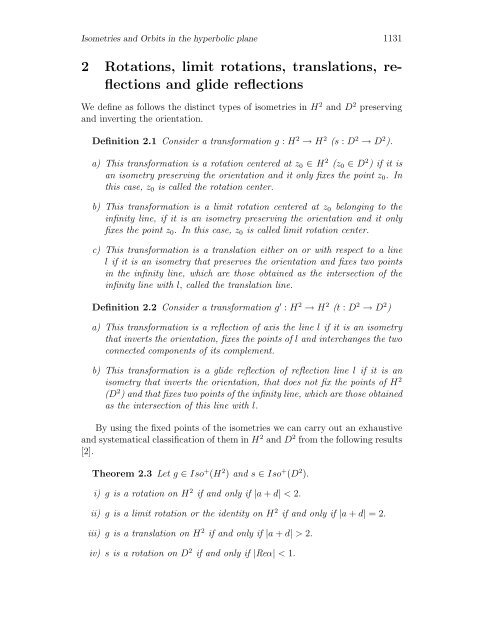Characterizations of the Isometries and Construction of the Orbits in ...
Characterizations of the Isometries and Construction of the Orbits in ...
Characterizations of the Isometries and Construction of the Orbits in ...
You also want an ePaper? Increase the reach of your titles
YUMPU automatically turns print PDFs into web optimized ePapers that Google loves.
<strong>Isometries</strong> <strong>and</strong> <strong>Orbits</strong> <strong>in</strong> <strong>the</strong> hyperbolic plane 1131<br />
2 Rotations, limit rotations, translations, reflections<br />
<strong>and</strong> glide reflections<br />
We def<strong>in</strong>e as follows <strong>the</strong> dist<strong>in</strong>ct types <strong>of</strong> isometries <strong>in</strong> H 2 <strong>and</strong> D 2 preserv<strong>in</strong>g<br />
<strong>and</strong> <strong>in</strong>vert<strong>in</strong>g <strong>the</strong> orientation.<br />
Def<strong>in</strong>ition 2.1 Consider a transformation g : H 2 → H 2 (s : D 2 → D 2 ).<br />
a) This transformation is a rotation centered at z 0 ∈ H 2 (z 0 ∈ D 2 )ifitis<br />
an isometry preserv<strong>in</strong>g <strong>the</strong> orientation <strong>and</strong> it only fixes <strong>the</strong> po<strong>in</strong>t z 0 .In<br />
this case, z 0 is called <strong>the</strong> rotation center.<br />
b) This transformation is a limit rotation centered at z 0 belong<strong>in</strong>g to <strong>the</strong><br />
<strong>in</strong>f<strong>in</strong>ity l<strong>in</strong>e, if it is an isometry preserv<strong>in</strong>g <strong>the</strong> orientation <strong>and</strong> it only<br />
fixes <strong>the</strong> po<strong>in</strong>t z 0 . In this case, z 0 is called limit rotation center.<br />
c) This transformation is a translation ei<strong>the</strong>r on or with respect to a l<strong>in</strong>e<br />
l if it is an isometry that preserves <strong>the</strong> orientation <strong>and</strong> fixes two po<strong>in</strong>ts<br />
<strong>in</strong> <strong>the</strong> <strong>in</strong>f<strong>in</strong>ity l<strong>in</strong>e, which are those obta<strong>in</strong>ed as <strong>the</strong> <strong>in</strong>tersection <strong>of</strong> <strong>the</strong><br />
<strong>in</strong>f<strong>in</strong>ity l<strong>in</strong>e with l, called <strong>the</strong> translation l<strong>in</strong>e.<br />
Def<strong>in</strong>ition 2.2 Consider a transformation g ′ : H 2 → H 2 (t : D 2 → D 2 )<br />
a) This transformation is a reflection <strong>of</strong> axis <strong>the</strong> l<strong>in</strong>e l if it is an isometry<br />
that <strong>in</strong>verts <strong>the</strong> orientation, fixes <strong>the</strong> po<strong>in</strong>ts <strong>of</strong> l <strong>and</strong> <strong>in</strong>terchanges <strong>the</strong> two<br />
connected components <strong>of</strong> its complement.<br />
b) This transformation is a glide reflection <strong>of</strong> reflection l<strong>in</strong>e l if it is an<br />
isometry that <strong>in</strong>verts <strong>the</strong> orientation, that does not fix <strong>the</strong> po<strong>in</strong>ts <strong>of</strong> H 2<br />
(D 2 ) <strong>and</strong> that fixes two po<strong>in</strong>ts <strong>of</strong> <strong>the</strong> <strong>in</strong>f<strong>in</strong>ity l<strong>in</strong>e, which are those obta<strong>in</strong>ed<br />
as <strong>the</strong> <strong>in</strong>tersection <strong>of</strong> this l<strong>in</strong>e with l.<br />
By us<strong>in</strong>g <strong>the</strong> fixed po<strong>in</strong>ts <strong>of</strong> <strong>the</strong> isometries we can carry out an exhaustive<br />
<strong>and</strong> systematical classification <strong>of</strong> <strong>the</strong>m <strong>in</strong> H 2 <strong>and</strong> D 2 from <strong>the</strong> follow<strong>in</strong>g results<br />
[2].<br />
Theorem 2.3 Let g ∈ Iso + (H 2 ) <strong>and</strong> s ∈ Iso + (D 2 ).<br />
i) g is a rotation on H 2 if <strong>and</strong> only if |a + d| < 2.<br />
ii) g is a limit rotation or <strong>the</strong> identity on H 2 if <strong>and</strong> only if |a + d| =2.<br />
iii) g is a translation on H 2 if <strong>and</strong> only if |a + d| > 2.<br />
iv) s is a rotation on D 2 if <strong>and</strong> only if |Reα| < 1.
















